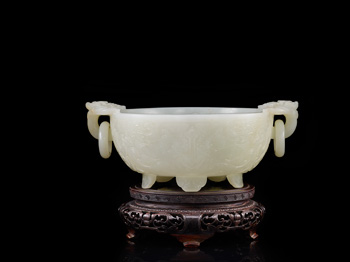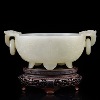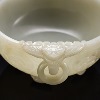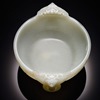PROVENANCE: Sotheby's Hong Kong, 30 October 2000, lot 353 White jade with its transparent body, lustrous and bright characteristics, is defined in the Shuwen as “the fairest of stones.” Indeed the taotie on the present lot is perhaps the most frequently recurring motif used in the art of the jade carvers especially during the reign of Qianlong, when it was fashionable to create decorative objects imitating old masterpieces or imparting them with the elegant air of antiquity. Compare with a vase dated to the Qianlong period similarly worked with lappets and the taotie masks is currently residing at the National Palace Museum in Taipei, illustrated in The complete collection of treasures of the palace museum. Jareware III, pl.148, p.181. For more marriage bowls resting on similar ruyi shaped feet, see Jade a study in Chinese archaeology and religion, pl. L, pl. CXXVIII and pl. CXXIX on pp.325-328. See another, illustrated in Chinese jades of five centuries, Charles E. Tuttle company, Tokyo, pl.37, pp.128-129. See also another, illustrated in The complete collection of treasures of the palace museum. Jareware III, Hong Kong, 1995, pl.59, p.71. Compare with a similar marriage bowl sold at Sotheby’s Hong Kong, 8 October 2010, lot 2616.
|
8109
AN ARCHAISTIC WHITE JADE MARRIAGE BOWLS
QIANLONG AND OF THE PERIOD (1736-1795) |
|
The heavily constructed bulbous vessel of semi-spherical form delicately carved on the exterior with a centralized taotie below two confronting archaic birds and further scrollwork, flanked on the sides with loose ring handles suspended from auspicious bats at the rim, all supported on five ruyi-shaped feet, the stone of an even luscious colour. |
|
Estimate
5,000,000 - 7,000,000 19,531,000 - 27,344,000 644,300 - 902,100
|
|
Sold Price 6,240,000
24,186,047
805,161
|
|
|
PROVENANCE: Sotheby's Hong Kong, 30 October 2000, lot 353 White jade with its transparent body, lustrous and bright characteristics, is defined in the Shuwen as “the fairest of stones.” Indeed the taotie on the present lot is perhaps the most frequently recurring motif used in the art of the jade carvers especially during the reign of Qianlong, when it was fashionable to create decorative objects imitating old masterpieces or imparting them with the elegant air of antiquity. Compare with a vase dated to the Qianlong period similarly worked with lappets and the taotie masks is currently residing at the National Palace Museum in Taipei, illustrated in The complete collection of treasures of the palace museum. Jareware III, pl.148, p.181. For more marriage bowls resting on similar ruyi shaped feet, see Jade a study in Chinese archaeology and religion, pl. L, pl. CXXVIII and pl. CXXIX on pp.325-328. See another, illustrated in Chinese jades of five centuries, Charles E. Tuttle company, Tokyo, pl.37, pp.128-129. See also another, illustrated in The complete collection of treasures of the palace museum. Jareware III, Hong Kong, 1995, pl.59, p.71. Compare with a similar marriage bowl sold at Sotheby’s Hong Kong, 8 October 2010, lot 2616.




